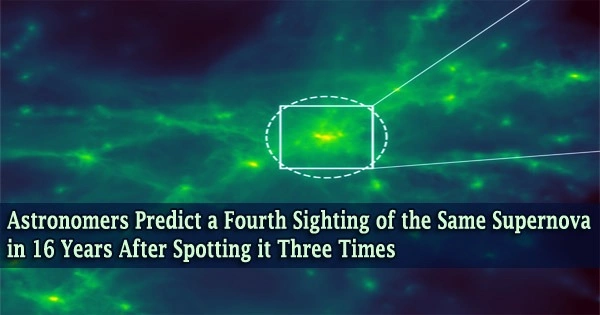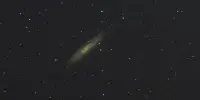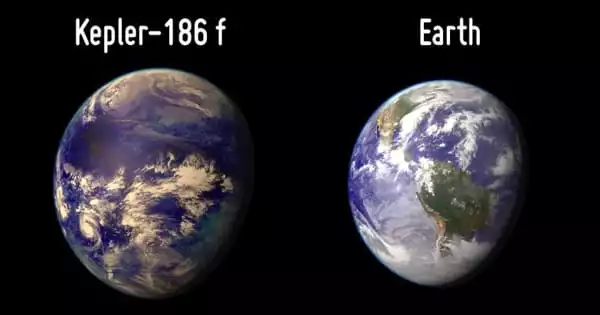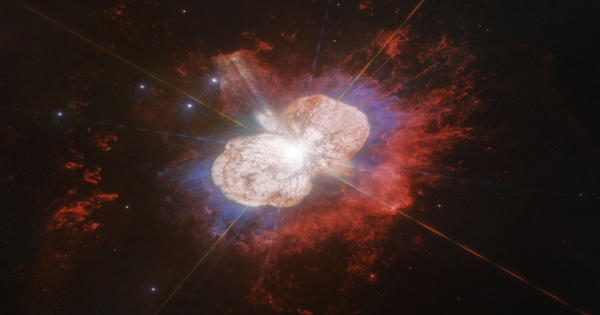Space curves so greatly due to the strong gravitational pull of a group of far-off galaxies that light from them comes to us from many different angles. The same exploding star could be seen by University of Copenhagen astronomers in three separate locations in the heavens thanks to the “gravitational lensing” effect.
By 2037, a fourth sighting of the same explosion is expected, according to their predictions. The study, which was just published in the journal Nature Astronomy, offers a rare chance to investigate both the supernova itself and the universe’s expansion.
One of the most intriguing features of Einstein’s famous theory of relativity is that gravity is now referred to as a “curvature” of space rather than a force. Heavy objects can bend space, which can affect not just how planets circle stars but also how light beams travel across it.
Galaxy clusters, the heaviest formations in the cosmos, can bend light from distant galaxies behind them so much that they appear to be in an entirely different location than they actually are. Galaxy clusters are made up of hundreds or thousands of galaxies.
But that’s not all; using a large telescope, we can get lucky and see the same galaxy twice or more in various locations in the sky. Light can travel along a number of pathways around a galaxy cluster.
Supernova déjà-vu
It takes longer to travel some routes around a galaxy cluster because they are longer. Another astounding result of relativity is that gravity gets stronger the slower the path is traveled. This delays the time it takes for light to reach us, changing the types of images we may perceive.
Understanding the structure of the universe is going to be a top priority for the main earth-based observatories and international space organizations over the next decade.Studies planned for the future will cover much of the sky and are expected to reveal dozens or even hundreds of rare gravitational lenses with supernovae like SN Requiem.
Gabriel Brammer
The Cosmic Dawn Center, a basic research facility run by the Niels Bohr Institute at the University of Copenhagen and DTU Space at the Technical University of Denmark along with their international partners, has made it possible for a team of astronomers to observe a single galaxy in at least four different locations in the sky.
The observations were made using the infrared wavelength range of the Hubble Space Telescope.
Researchers used Hubble data analysis to identify three brilliant light sources in a background galaxy that were seen in images from 2016 but vanished when Hubble returned to the region in 2019. These three sources turned out to be various pictures of a single star whose existence was cut short by a supernova explosion.
“A single star exploded 10 billion years ago, long before our own sun was formed. The flash of light from that explosion has just reached us,” explains Associate Professor Gabriel Brammer of the Cosmic Dawn Center, who led the study with Professor Steven Rodney of the University of South Carolina.
Three of the four “mirrored images” of the galaxy contain the supernova, also known as “SN-Requiem.” The development of the explosive supernova is seen differently in each photograph.
It hasn’t yet exploded in the last two pictures. However, it is feasible to determine how “delayed” these images are by looking at how galaxies are dispersed inside the galaxy cluster and how these images are deformed by curved space.
This has allowed astronomers to make a remarkable prediction:
“The fourth image of the galaxy is roughly 21 years behind, which should allow us to see the supernova explode one more time, sometime around 2037,” explains Gabriel Brammer.
Can teach us more about the universe
If the SN-Requiem explosion occurs once more in 2037, it will not only corroborate our understanding of gravity but also provide insight into another cosmic conundrum that has just come to light: the expansion of our universe.
We can measure the rate of expansion using a variety of techniques, and we are aware that the universe is expanding. Even when measurement errors are taken into account, the various measuring techniques do not all yield the same results, which is the issue.
Could our observational techniques be flawed, or more interestingly will we need to revise our understandings of fundamental physics and cosmology?
“Understanding the structure of the universe is going to be a top priority for the main earth-based observatories and international space organizations over the next decade.Studies planned for the future will cover much of the sky and are expected to reveal dozens or even hundreds of rare gravitational lenses with supernovae like SN Requiem,” Brammer elaborates:
“Accurate measurements of delays from such sources provide unique and reliable determinations of cosmic expansion and can even help reveal the properties of dark matter and dark energy.”
We can only observe 5% of the enigmatic matter that is thought to make up 95% of our universe, known as dark matter and dark energy. The perspectives of gravitational lenses are promising!
















